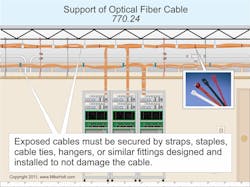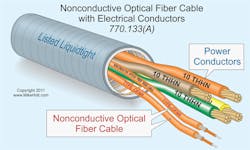Time for a quick pop quiz. Where does the NEC provide all of its requirements for wiring methods? If you answered Chapter 3, you are almost correct. When installing optical fiber cables, the requirements for wiring methods are located in Art. 770. Only when Art. 770 references sections in Chapter 2 and Art. 300 do these apply to optical fiber cables and raceways [770.3].
For example, subsection 770.113 refers to 300.22, which applies when installing optical fiber cables and optical fiber raceways in ducts and plenum spaces. Article 770 does not refer to 300.15, so you do not have to put optical splices in boxes.
Article 770 also applies to composite cables, which combine optical fibers with current-carrying conductors. You can use these only where the optical fibers and current-carrying electrical conductors are functionally associated [770.133(A)]. Because the NEC considers these electrical cables [770.3(B)], they must comply with the appropriate requirements of Chapter 1 through Chapter 4.
Mechanicals matter
You must install equipment and cabling in a neat and workmanlike manner [770.24]. One of the implications of this is the routing of your cables cannot interfere with access to equipment [770.21]. For example, you must run them so they are not resting on top of ceiling tiles in a way that blocks access.
Ideally, you will run those cables with supports that fasten to frame members. But such an approach in a ceiling space is not always cost-effective or even possible. However, you must take this approach for exposed cables to ensure the cable will not be damaged by normal building use. Secure the cables with straps, staples, hangers, cable ties, or similar fittings designed and installed in a manner that won’t damage the cable (Fig. 1).
You can support raceways and cables by independent support wires attached to the suspended ceiling per 300.11(A). Do not use the ceiling-support wires or ceiling grid directly [300.11]. In addition, do not strap, tape, or attach optical fiber cables (or any other kind of cable) to the exterior of any raceway as a means of support [770.133(D)].
Cables installed through (or parallel to) framing members or furring strips must be protected where they are likely to be penetrated by nails or screws. Install the wiring method so it is at least 1¼ in. from the nearest edge of the framing member or furring strips, or is protected by a 1⁄16-in.-thick steel plate or the equivalent [300.4(D)].
You’ll find the accepted industry practices in ANSI/NECA/BICSI 568, “Standard for Installing Commercial Building Telecommunications Cabling” and ANSI/NECA/FOA 301, “Standard for Installing and Testing Fiber Optic Cables.” See NFPA 90A-2009, “Standard for the Installation of Air-Conditioning and Ventilating Systems,” for discrete combustible components installed per 300.22(B) and (C). NFPA 90A-2009 does not require support hardware to be listed, but NFPA 90A-2009 has heat release and smoke emissions requirements for cable ties in sections 4.3.11.2.6.5 (plenums) and 4.3.11.5.5.6 (raised floor plenums).
Stop combustion spread
One way to reduce the spread of fire or products of combustion within a building is to remove abandoned cables [770.25]:
• If you do not terminate some cables because they are for future use, make sure you identify each one with a tag that can withstand the environment involved. This way, it’s easy to distinguish them from abandoned cables.
• If a cable does not terminate and is not for future use, then you must remove the accessible portion of it. Cables installed in concealed raceways are not considered “accessible,” so you do not have to remove them.
Another way is install cables and raceways with proper firestopping [770.26]:
• Firestop any openings in fire-rated walls, floors, and
ceilings for electrical equipment.
• Use firestop material listed for the specific types of wiring methods and construction structures.
• Use firestop methods approved by the AHJ to maintain the fire-resistance rating of the fire-rated assembly (Fig. 2).
You also need to use methods that do not substantially increase the risk of spreading combustion. For example:
• Directories of electrical construction materials published by qualified testing laboratories contain listing and installation restrictions necessary to maintain the fire-resistive rating of assemblies [770.26 Note].
• Outlet boxes must have a horizontal separation at least 24 in. when installed in a fire-rated assembly, unless an outlet box is listed for closer spacing or protected by fire-resistant “putty pads” per manufacturer’s instructions.
Listing
Install listed optical fiber cables and raceways as indicated in Table 770.154(A) and as limited by 770.113. You can use cable substitutions per Table 770.154(B). For indoor installations, optical fiber cables must be listed [770.179].
What if you have unlisted cables entering a building? First, understand what the “point of entrance” is — the point within a building at which the optical fiber cable emerges from one of these [770.2]: external wall; concrete floor slab; or rigid metal conduit or an intermediate metal conduit connected by a grounding conductor to an electrode per 770.100.
You can install unlisted optical fiber cables in building spaces (other than risers, ducts, or plenum spaces), if the length of the optical fiber cable measured from its point of entrance does not exceed 50 ft and the optical fiber cable terminates in an enclosure. Unlisted nonconductive outside optical fiber cables can enter the building up to 50 ft (point of entrance) [770.48].
Raceway
You can install optical fiber cables in any Chapter 3 raceway per the requirements of Chapter 3 [770.110(A)]. Furthermore, you can install listed optical fiber raceways as innerduct in any Chapter 3 raceway. You also have the option of installing them in listed optical fiber raceways per 362.24 through 362.56.
Always install listed optical fiber raceways per the following ENT rules:
• 362.24 (Bending radius)
• 362.26 (Maximum total bends between pull points, 360°)
• 362.28 (Trimmed to remove rough edges)
•362.30 (Support every 3 ft, within 3 ft of any enclosure)
• 362.48 (Joints between tubing, fittings, and boxes)
What about raceway fill? The raceway fill tables of Chapter 3 and Chapter 9 apply if you install optical fiber cables in a raceway with current-carrying conductors; otherwise, they don’t [770.110(B)].
Ducts vs. plenums
If you run fiber-optic cables in fabricated ducts used for environmental air and install them per 300.22(B), you can choose from eight permissible cable types. The options and requirements, listed in 770.113(B), are straightforward. But in plenum spaces used for environmental air, the requirements are more complex [770.113(B)]. The reason is the ductwork helps confine the products of combustion while a plenum space is unlikely to do so.
The typical plenum space is incidentally created during construction. For example, the space between two sides of an interior wall becomes a plenum when connected to the air distribution system. These are typically passive parts of the air distribution system (cold air returns, for example) and thus aren’t typically sealed. They are often made of combustible materials.
By contrast, ductwork is typically fabricated from sheet metal. It is usually sealed to reduce energy losses due to air leakage, thus further inhibiting the spread of combustion.
Mixing with conductors
You can run composite cable that includes optical fibers and power circuits, if the functions of the optical fibers and the electrical conductors are associated. Conductive optical fiber cables aren’t permitted to occupy a cable tray or raceway with electric light, power or Class 1 circuits [770.133].
Nonconductive optical fiber cables:
• Can occupy a cable tray or raceway with conductors for electric light, power, and Class 1 circuits (Fig. 3).
• Cannot occupy a cabinet, outlet box, panel, or similar enclosure housing the electrical terminations of an electric light, power, or Class 1 circuit — unless the nonconductive optical fiber cable is functionally associated with the electric light, power, or Class 1 circuit.
Optical fiber cables can be in the same raceway, cable tray, cable routing assembly, or enclosure with conductors of any of the following:
• Communications circuits complying with Parts I and IV of Art. 800.
• Coaxial cables complying with Parts I and IV of Art. 820.
• Class 2 and Class 3 circuits complying with Parts I and III of Art. 725.
• Power-limited fire alarm circuits complying with Parts I and III of Art. 760.
Final fiber thoughts
Because optical fibers don’t carry current, the normal NEC rules related to ampacity don’t apply — unless, of course, you run them with current-carrying conductors or use a fiber-conductor composite cable. Where run in environmental air space, you must account for by-products of combustion. Protecting those optical fibers from damage is a key factor underlying other Art. 770 requirements.
About the Author

Mike Holt
Mike Holt is the owner of Mike Holt Enterprises (www.MikeHolt.com), one of the largest electrical publishers in the United States. He earned a master's degree in the Business Administration Program (MBA) from the University of Miami. He earned his reputation as a National Electrical Code (NEC) expert by working his way up through the electrical trade. Formally a construction editor for two different trade publications, Mike started his career as an apprentice electrician and eventually became a master electrician, an electrical inspector, a contractor, and an educator. Mike has taught more than 1,000 classes on 30 different electrical-related subjects — ranging from alarm installations to exam preparation and voltage drop calculations. He continues to produce seminars, videos, books, and online training for the trade as well as contribute monthly Code content to EC&M magazine.



